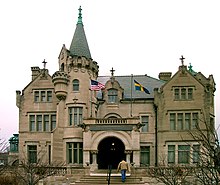Religions outside the Judeo-Christian mainstream also have a home in the city. During the mid-to-late 1950s, members of the Nation of Islam created a temple in north Minneapolis,[83] and the first mosque was built in 1967.[84] In 1972 a relief agency resettled the first Shi'a Muslim family from Uganda. By 2004, between 20,000 and 30,000 Somali Muslims made the city their home.[85] In 1972, Dainin Katagiri was invited from California to Minneapolis—by one account, a place he thought nobody else would want to go—where he founded a lineage which today includes three Sōtō Zen centers among the city's nearly 20 Buddhist and meditation centers.[86][87] Atheists For Human Rights has its headquarters in the Shingle Creek neighborhood in a geodesic dome.[88] Minneapolis has had a chartered local body of Ordo Templi Orientis since 1994.[89]
Economy
See also: Economy of Minnesota
White U.S. Bancorp towers reflected in the Capella Tower
Five Fortune 500 corporations make their headquarters within the city limits of Minneapolis: Target, U.S. Bancorp, Xcel Energy, Ameriprise Financial and Thrivent Financial.[92] As of 2015 the city's largest employers downtown are Target, Wells Fargo, HCMC, Hennepin County, Ameriprise, U.S. Bancorp, Xcel Energy, City of Minneapolis, RBC Wealth Management, the Star Tribune, Capella Education Company, Thrivent, CenturyLink, ABM Industries, and the Federal Reserve Bank of Minneapolis.[93]
Target Corporation's 361,000 employees operate 1,801 stores in all U.S. states except Vermont.[94]
Availability of Wi-Fi, transportation solutions, medical trials, university research and development expenditures, advanced degrees held by the work force, and energy conservation are so far above the national average that in 2005, Popular Science named Minneapolis the "Top Tech City" in the U.S.[99] The Twin Cities was ranked as the country's second best city in a 2006 Kiplinger's poll of Smart Places to Live and Minneapolis was one of the Seven Cool Cities for young professionals.[100]
The Twin Cities contribute 63.8% of the gross state product of Minnesota. Measured by gross metropolitan product per resident ($62,054), Minneapolis is the fifteenth richest city in the U.S.[101] The area's $199.6 billion gross metropolitan product and its per capita personal income rank thirteenth in the U.S.[102] Recovering from the nation's recession in 2000, personal income grew 3.8% in 2005, though it was behind the national average of 5%. The city returned to peak employment during the fourth quarter of that year.[103]
The Federal Reserve Bank of Minneapolis, serves Minnesota, Montana, North and South Dakota, and parts of Wisconsin and Michigan. The smallest of the 12 regional banks in the Federal Reserve System, it operates a nationwide payments system, oversees member banks and bank holding companies, and serves as a banker for the U.S. Treasury.[104] The Minneapolis Grain Exchange founded in 1881 is still located near the riverfront and is the only exchange for hard red spring wheat futures and options.[105]
Culture
Minneapolis' cultural organizations draw creative people and audiences to the city for theater, visual art, writing and music. The community's diverse population also continues to manage a long tradition of charitable support through progressive public social programs, VOLAGs and volunteering, as well as through private and corporate philanthropy.[106][107]Visual arts
Main article: Arts in Minneapolis
The Minneapolis Institute of Art is open every day and offers free admission. Rembrandt's Lucretia (1666) is part of its collection of more than 100,000 objects.[108]
The Minneapolis Institute of Art, designed by McKim, Mead & White in 1915 in south central Minneapolis, is the largest art museum in the city, with 100,000 pieces in its permanent collection. New wings, designed by Kenzo Tange and Michael Graves, opened in 1974 and 2006, respectively, for contemporary and modern works, as well as more gallery space.[110]
The Weisman Art Museum, designed by Frank Gehry for the University of Minnesota, opened in 1993. An addition which doubled the size of the galleries, also designed by Gehry, opened in 2011.[111] The Museum of Russian Art opened in a restored church in 2005[112] and exhibits a collection of 20th-century Russian art as well as lecture series, seminars, social functions and other special events.
USA Today voted the Northeast Minneapolis Arts District as the nation's best art district in 2015, citing 400 independent artists, a center at the Northrup King Building, and recurring annual events like Art-A-Whirl every spring, and the Fine Arts Show Art Attack and Casket Arts Quad's Cache open studio events in November.[113





